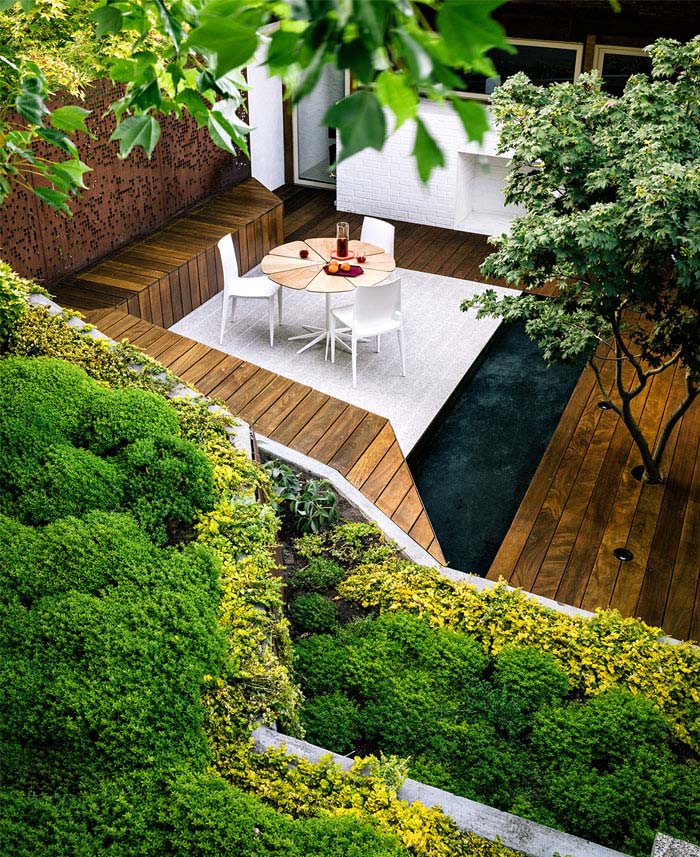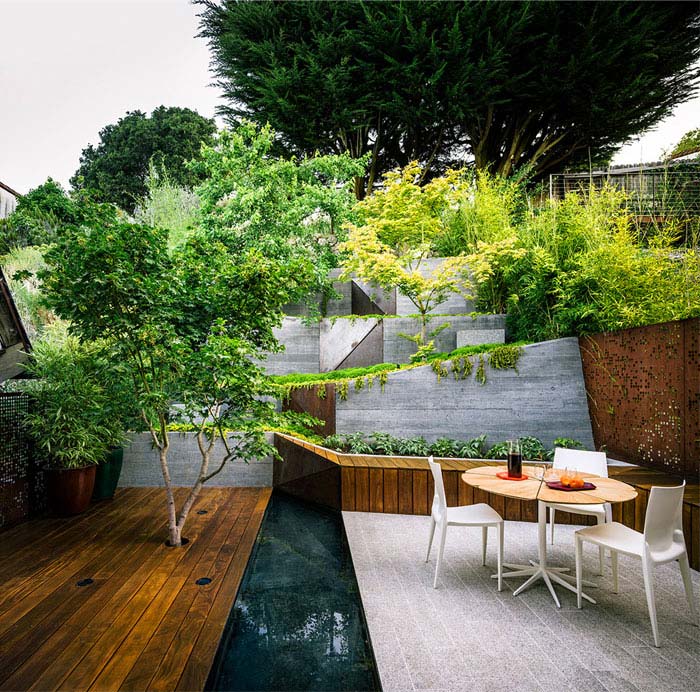We handpicked for you an impressive collection of ideas and visions all inspired from the Eastern philosophy that explores the connection between nature and human beings. We will commence with the brightest and most mesmerizing examples of traditional Zen Gardens, and we will explore the key elements which compose such gardens. We will also introduce to your attention some contemporary Asian Garden Ideas which can be applied in the backyards of modern houses. Some impressive public spaces inspired by the Zen philosophy will also be explored. And we will finish this article with Mini Zen Gardens’ ideas that can be introduced into the interior decor of any home.
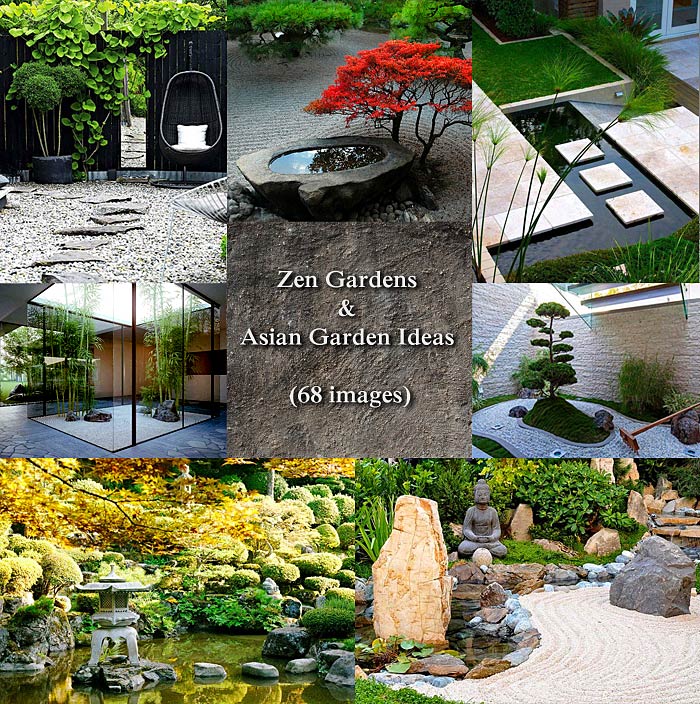
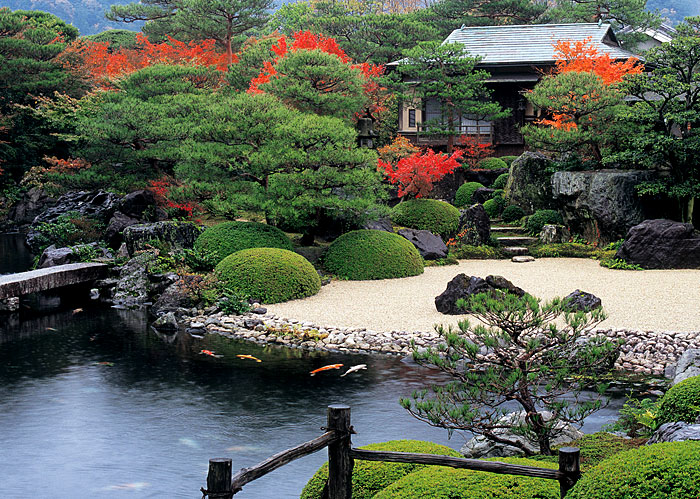
Traditional Zen Gardens ( Japanese Rock Gardens or Dry Landscapes )
Historically the original Zen Gardens are created by the Buddhist monks as spaces for solitude and meditation that simultaneously represent the human’s admiration for the beauty of nature. An inspired demonstration of the link between aesthetics and philosophy. Their origin of the gardens can be traced back to the late 14’ht century, and in the beginning, they were small secluded spaces into the monasteries borders composed mainly of gravel, rocks, and stones arranged in such a manner which closely represents a natural landscape scenery. The water impression was achieved through wave-like patterns in the gravel, and the rocks and stones were representatives of mountains and hills. Because of the lacking of water elements in this type of gardens they were also popular as Japanese Rock Gardens or Dry Asian Landscapes. This concept was developed and upgraded through the years and new elements – lakes, bridges, lighting and art installations were introduced. Today a Zen Garden is a collective term for all interpretations on the subjects that explore the inspiration of the Asian aesthetics, philosophy, and admiration for Nature.
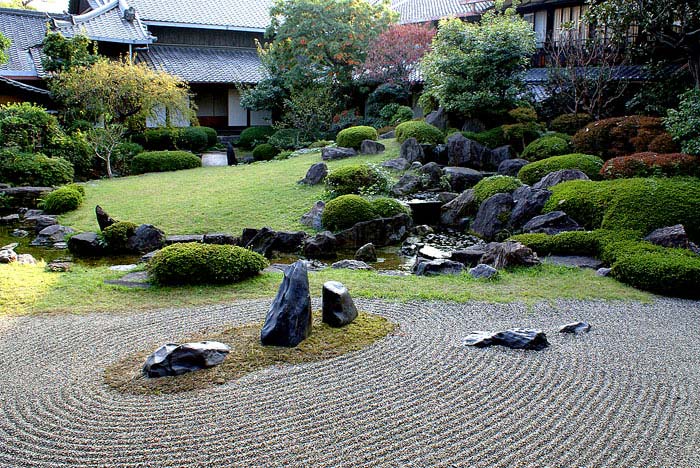
Because such gardens originally come from the Buddhist temples in Kyoto, the Zen gardens were with relatively small dimensions and surrounded by buildings and belt walls. Initially, the Zen garden was created only for the purpose of observation, and that was from a special place outside the garden itself. Often that was the veranda on which the eldest monk of the monastery was meditating. With the time the gardens were extended, the place of meditation was introduced inside the borders of the garden, and even specially arranged stone paths were composed so that the Zen garden can be explored form the inside.
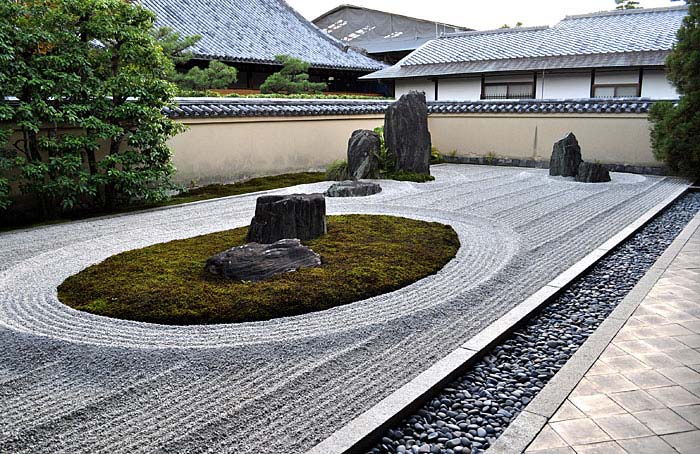
Although those gardens are thematically based on the natural landscapes the purpose of them is not so much to create an exacts replica of Nature more like they are aiming to compose a meditational space in which one can contemplate the meaning of existence. The essential elements in one Japanese Zen Garden are gravel, stones and in some cases moss. Such a garden is created to be felt not observed. The presence of living elements is minimal. There are no plants or lush vegetation, no objects created by humans. Although the Japanese Zen Gardens use the same basic components, each garden is unique in its compositional layout. There are not two similar gardens in the world – each carries different emotion, meaning and charge.
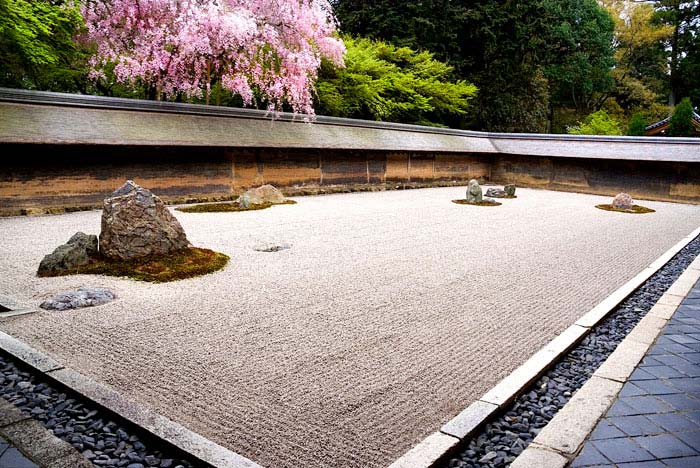
Elements of Asian Gardens
Through the years under the influence of different interactions between the Asian cultures the Zen gardens – originated in Japan – are supplemented with items from China and Korea, which leads to the emerge of a specific Asian style in the art of gardening. Many specific elements exist and used together, in combinations or singularly create the emanation of the so-called Asian Style Gardens оr Zen Gardens. Let’s explore the primary key groups of such elements…
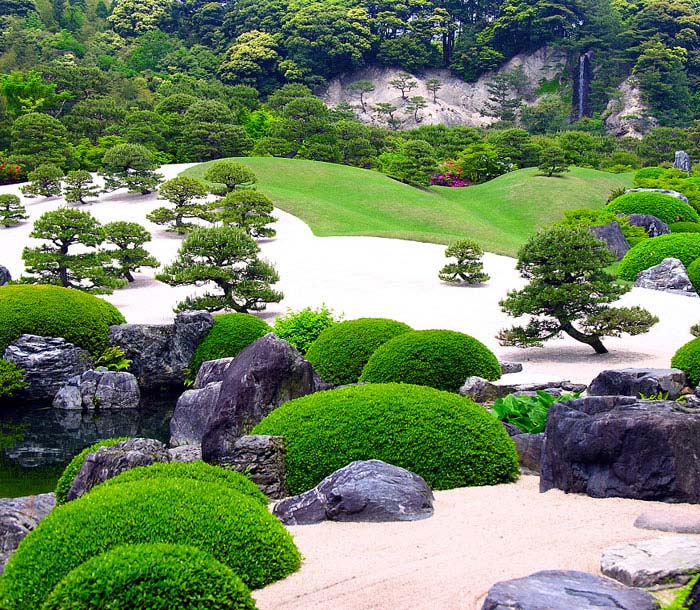
Rocks & Stones
The rocks and stones compositions are maybe the most important elements used in the Asian art of gardening. They exude power and stability combined with tranquility and timeless sensation. With their rough amorphous structure, they’re often used as a counterpoint to the soft vision of the sand and water elements – a contradiction that incites a deep reflection.
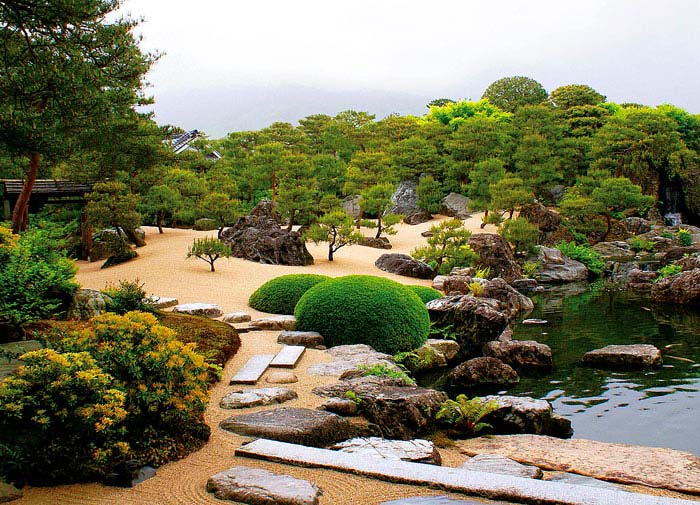
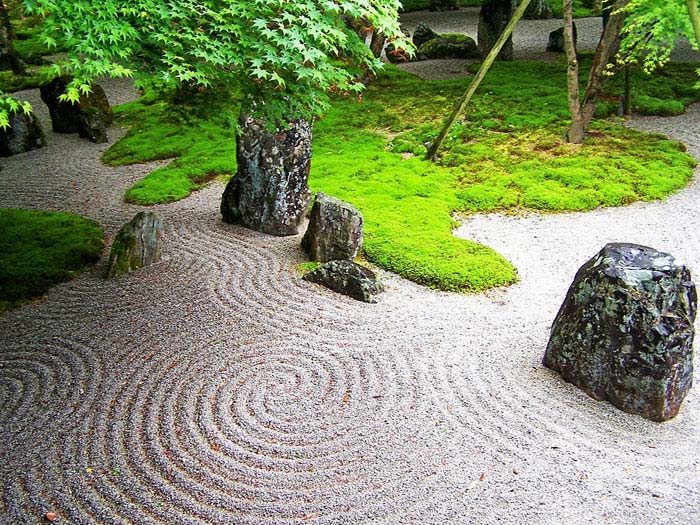
Raked Sand and Pebbles
In the stylized landscape composition of the Zen gardens the water premises – like seas and rivers – are represented through spaces of waved gravel. A multitude of carefully formed shallow furrows and patterns symbolize the waves and the movement of water which introduces the dynamics of it into the composition. Most commonly used are the crushed white or beige granite which is carefully shaped with specially designed rakes. Precisely those lines and waves of granite and gravel are amongst the most common and characteristic visual elements of Zen garden design.
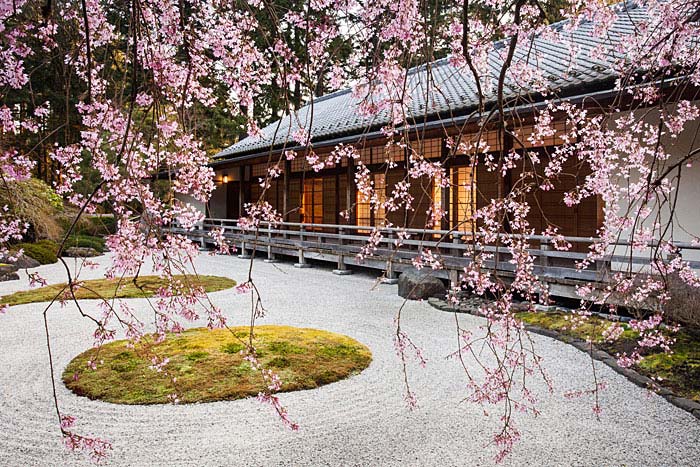

Koi Fish Ponds
The water is also an essential component in the Asian gardens. From fountains with troughs, through streams and cascades, to lakes with bridges – doesn’t matter the form in which this element is introduced, it brings character and charisma. The water goes “hand and hand” with the stone – representing the ying-yang dynamics they contradict and supplement each other in one continues harmony.

The famous Koi Fish add color and vitality to any water premise. They adapt equally well in big lakes or in small ponds in your backyard. As genuine pets, they get well accustomed to human presence and can be trained to take food from hand. Gorgeous and at the same time easy to maintain the Koi Fish becomes one of the trademarks of Asian culture and garden design.
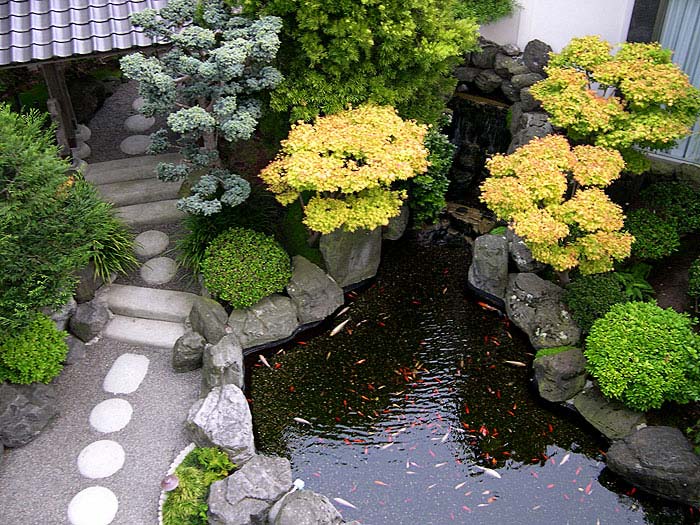
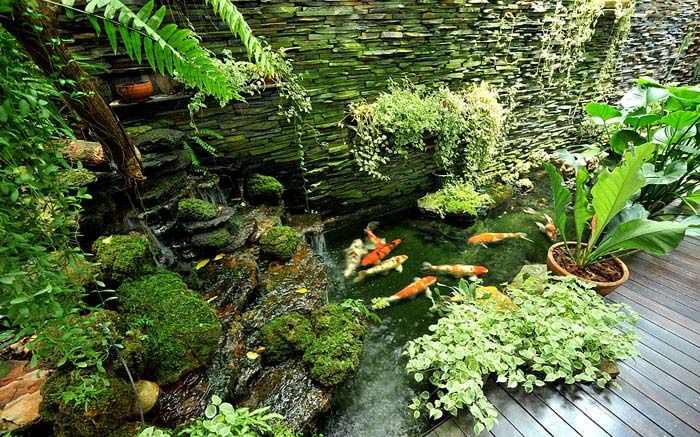
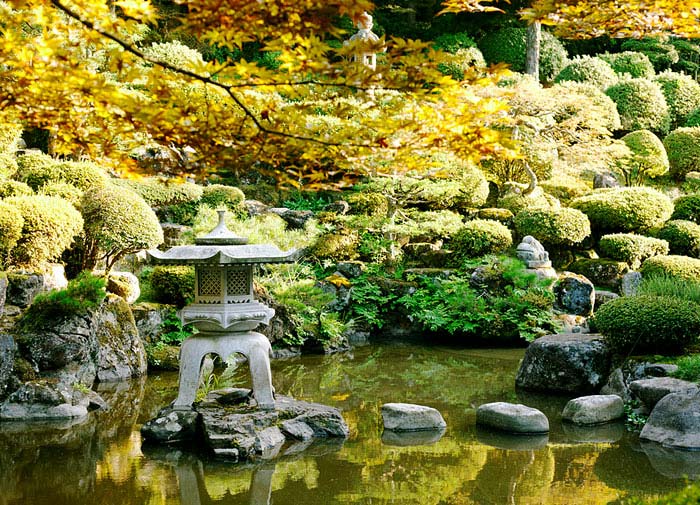
Stone Lanterns
And because one of the main aims of the Zen garden is to create a well-balanced and harmonious environment for meditation the man-made features are avoided in the garden design. The exceptions to that rule are the Stone Lanterns (also known as Pagoda Lights). They vary in forms and sizes, in detailing and decoration. Created to accustom the oil lamps and the candles the pagoda-shaped Stone Lanterns are arranged in special places throughout the garden and serve simultaneously as a lighting source and as art accents.
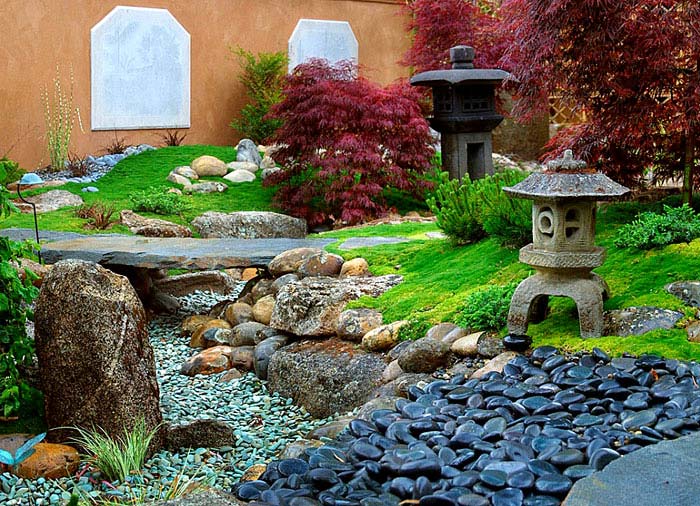
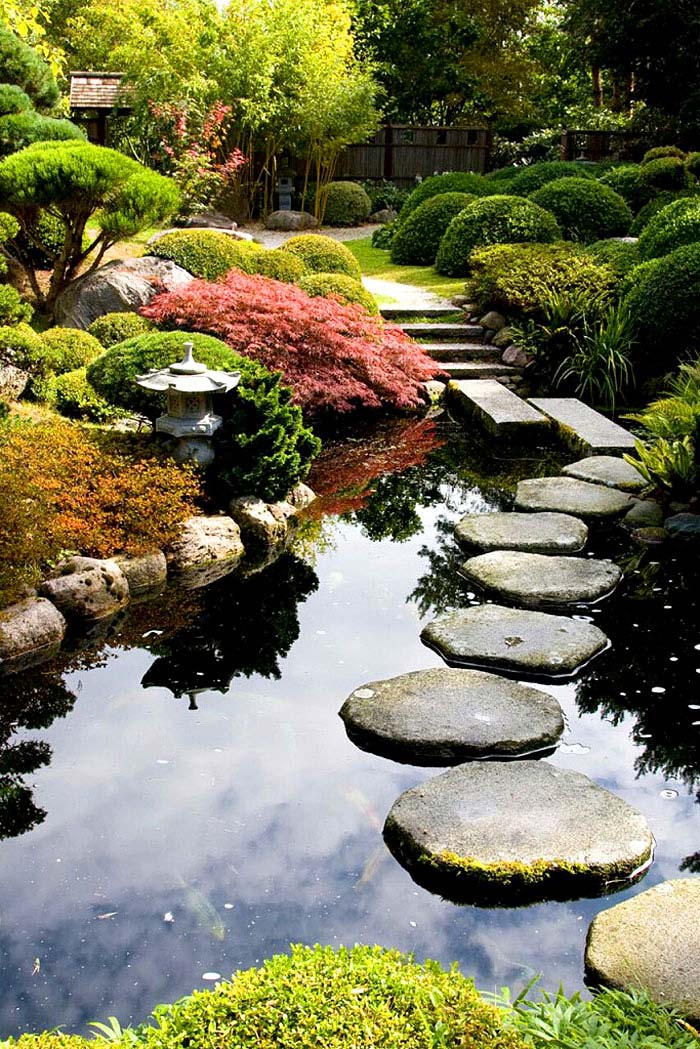
Stepping Stone Pathways
“Don’t leave anything to chance” is an important principle when it comes to Zen gardens design. Cautiously selected pats on which one can explore and feel the gardens spirit are one of the essential key elements in Asian gardening. Arraigning walking paths through the usage of Stepping Stone Pathways is essential for the right configuration of the design. Those pathways can lead through gravel, moss, grass and even water premises inviting you in this way on a step by step journey to discover the beauty and the spiritual secrets of a Zen garden.
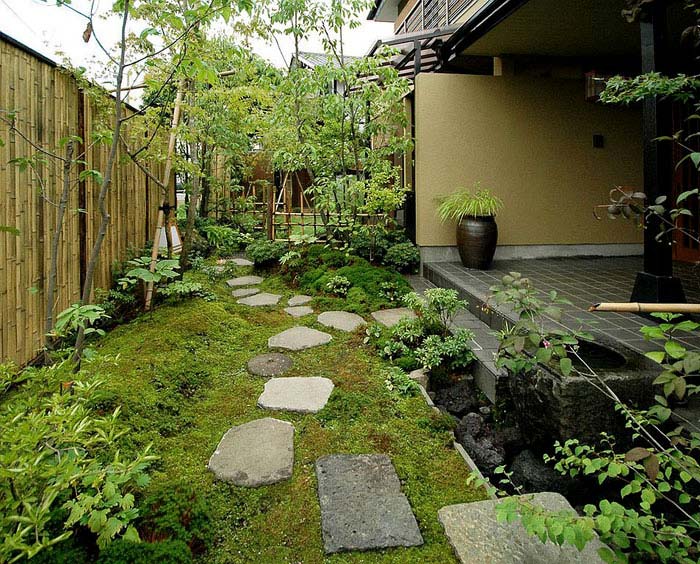
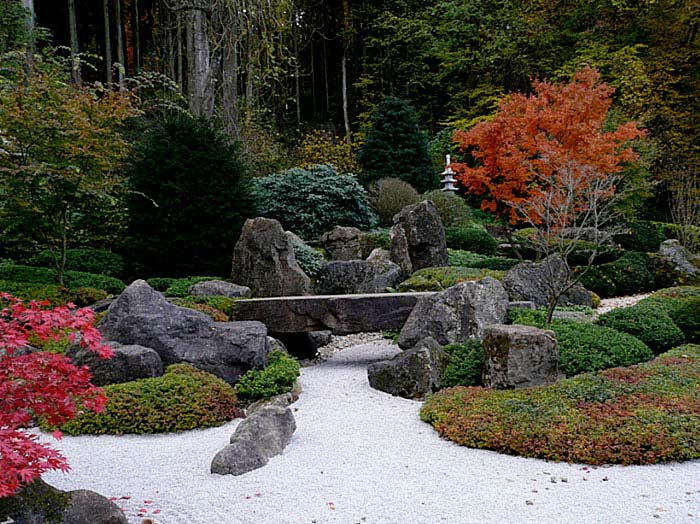
Stone Bridges
Another characteristic element is the bridge. It can be used in the gardens of mixed Asian type to cross the bodies of water or in dry stone gardens to create a dynamic composition of pathways in different levels. Natural materials are required for its creation, most often wood or stone. In the Japanese rock gardens, the bridges are composed mainly of one large rock piece that connects two hills. It can be used not only as a passage but also as a bench on which one can sit and relax.
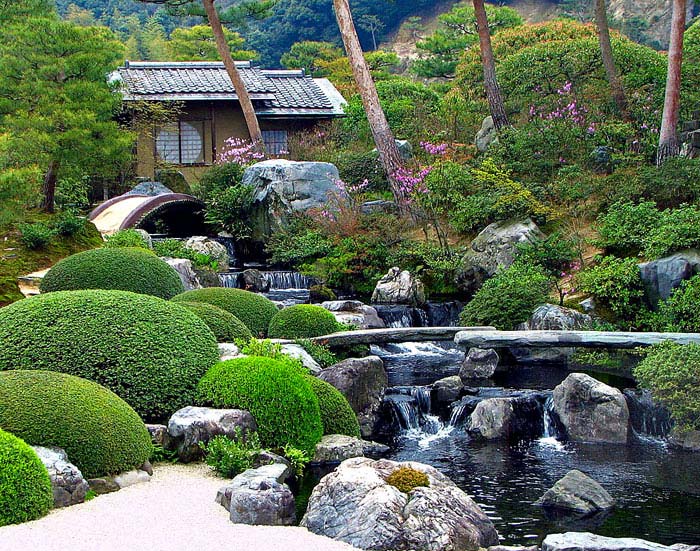
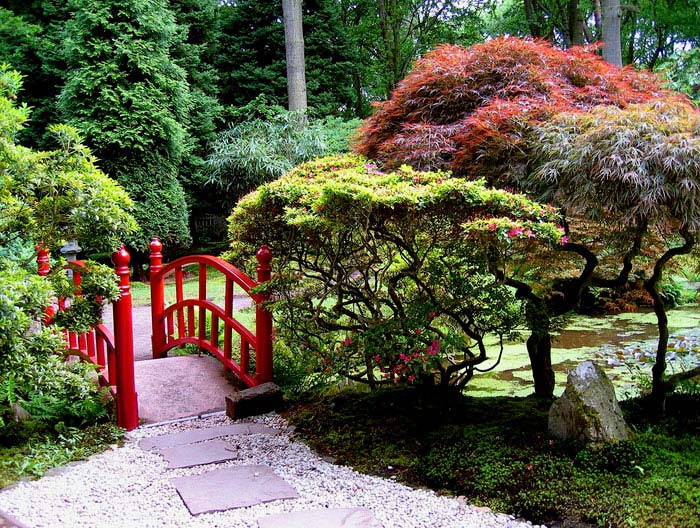
Arched Chinese Red Bridges
The red arched bridges are a unique trademark of the Chinese gardens. They are small in size and traditionally are composed entirely of wood. Their arched high point is usually the highest place in the garden that allows the best view of the surrounding beauty.
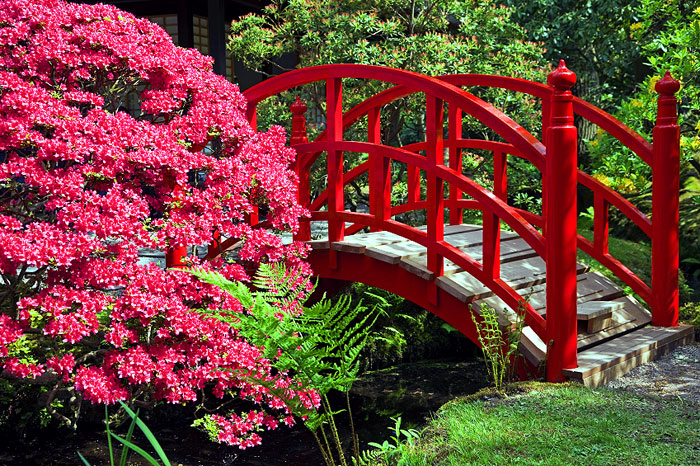
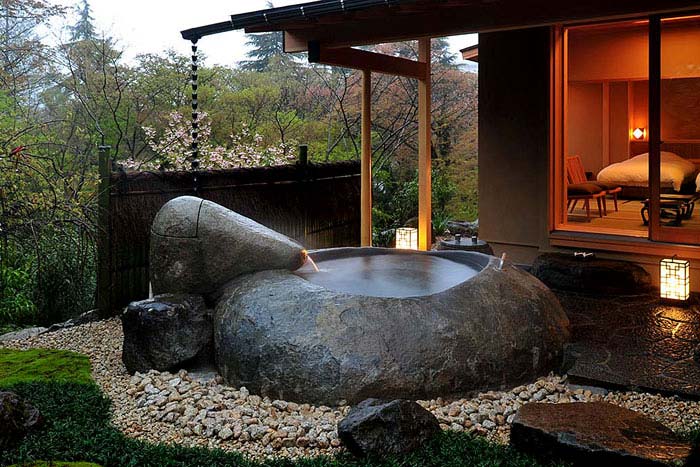
Stone Water Basins
The Stone water baths originate in Japan where they are traditionally used as a place to wash and clean before initiating a tea ceremony. Called tsukubai – literally “stopping basin” they are composed in such a manner that one must bow to use them. In this way, apart from the trivial purples of cleansing they also provoke certain humility of spirit and attune one with the spiritual aim of the tea ceremony. In today’s garden design the stone water baths bring more decorative value to the garden’s decor.
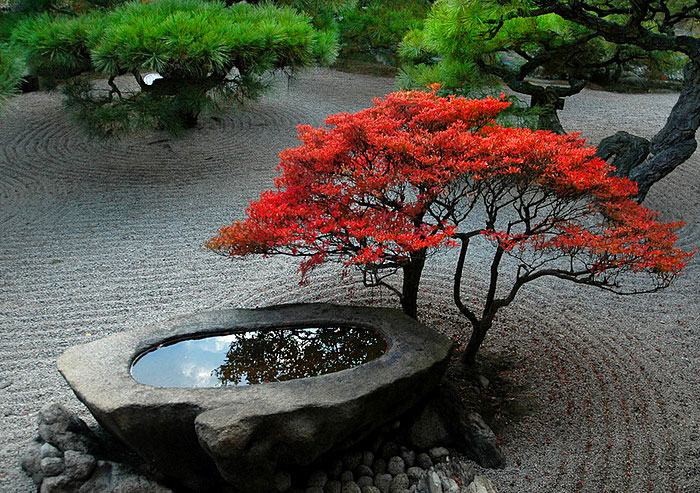
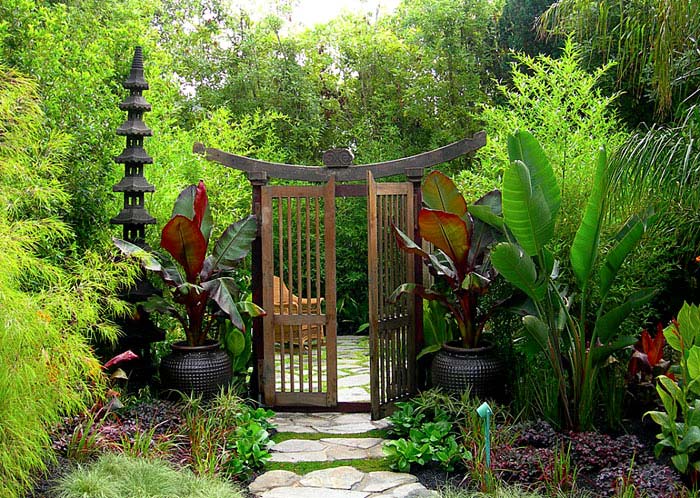
Zen Garden Gates
The Zen Garden Gates ( torii ) have mainly a decorative and symbolic function. Sometimes thy even lack the gate’s portals for closing – just a simple wooden frame in Asian style greets the visitors of the garden. Their symbolic presence serves to outline the borders of the garden and to create the spiritual sensation that once stepped under this arch one enters a different world.
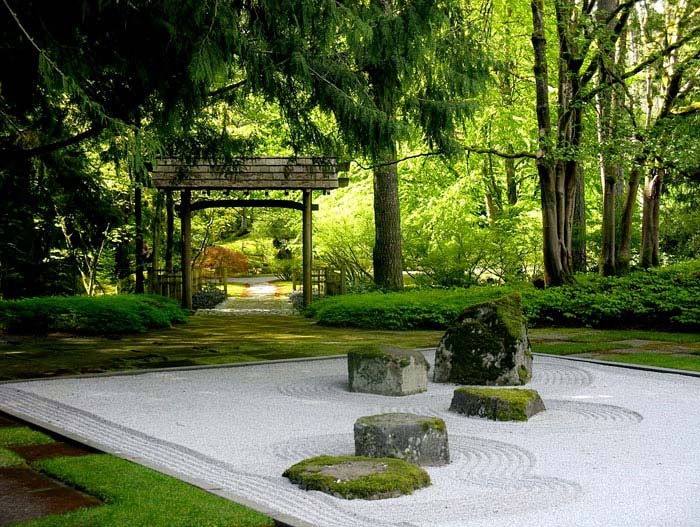

Moss Gardens
Because of its endurance under extremely harsh conditions, the moss often is the only living component of the Japanese Zen gardens. Viewed as a clam and unpretentious plant the moss needs the only shadow and moist to thrive. In the mild and humid Asian climate, the moss is widely spread. Its colors hues vary in a broad color range- from deep green to yellowish and can be successfully introduced in water gardens as well in dry arrangements.
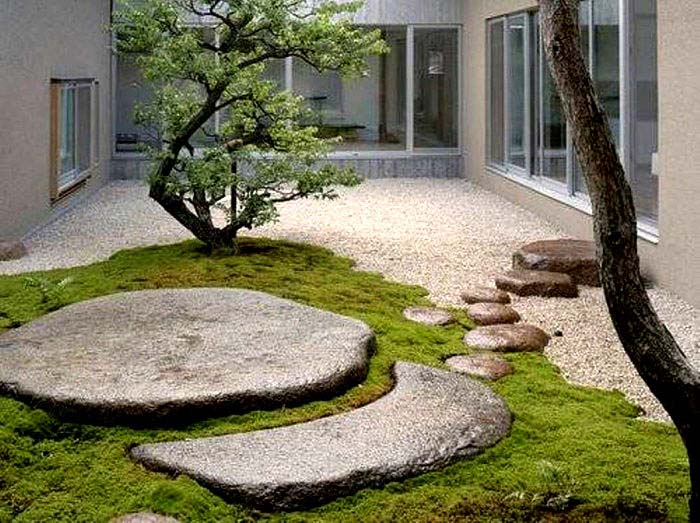

Statue of the Buddha
The statues of Buddha are another element of the Asian Zen gardens design. It is often used in its broad variety of cultural and artistic shapes. It represents a combination of human and nature elements, spiritual and artistic expressions. The statues are often placed in secluded meditative space deep inside the gardens. Another characteristic Asian statue introduction the Zen gardens are the dragons – they are very specific with their appearance and rich cultural meaning for this part of the world. Made from stone, ceramics or metal the Eastern statues in the garden carry particular Asian spirit into the design.
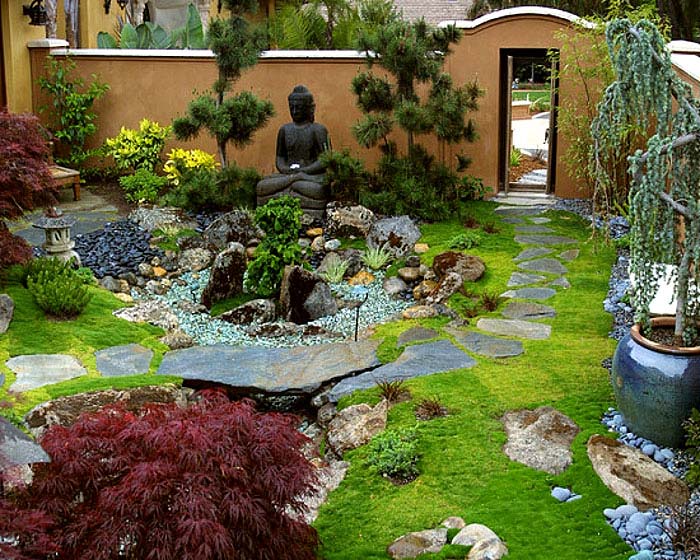
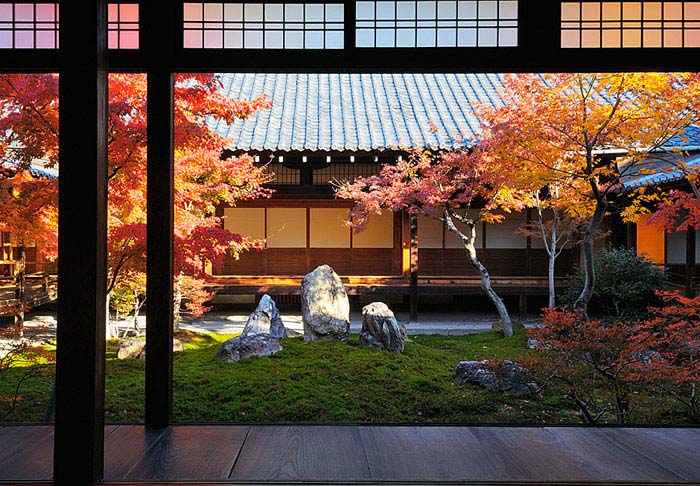
Japanese Maples
Japanese maple (Acer palmatum) is a deciduous tree that can reach a maximum of 6-8 meters of high and is characteristic for the territories of Japan, China, Korea and East Mongol. Its broad leaves have a distinctive pattern with five or seven peaks. The coloring of the trees can vary, but the most desired are the ones that have bright red colors.
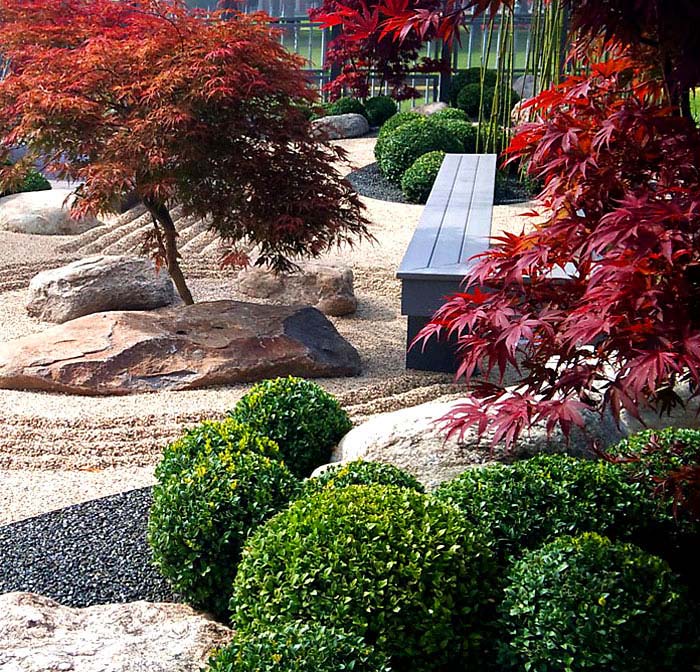
Precisely because of its spectacular colors and attractive silhouette the Japanese maple is a common choice for the art of Bonsai or the design of Asian landscape. Like with a brush of an artist the masters of Zen gardens add bold color spots introducing the living Japanese maple trees in their composition.
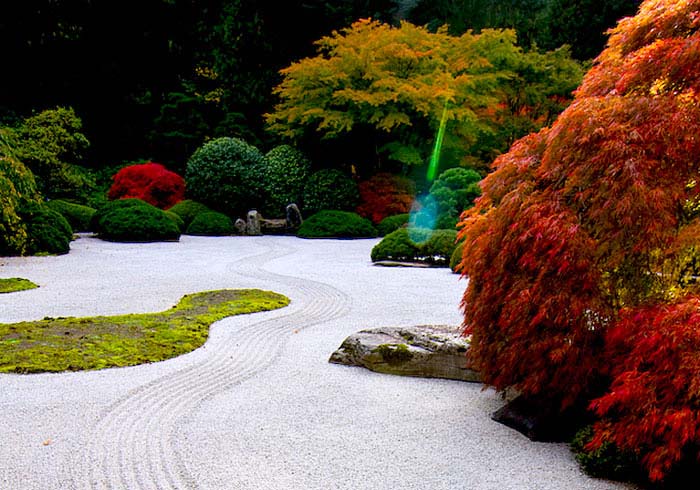
Contemporary Zen Backyards
In this part of the article, we will explore exciting examples of how the aesthetics of Asian Gardens can be translated in modern sets and homes. Because of the smaller spaces of today homes, the modern designers often need to combine contemporary and ancient garden elements, which is not an easy task at all. So we will elaborately explore how the elements of the traditional Asian garden design (which e viewed in the previous part of the article) can be set in concrete places, in what combinations and how they can compose the unique spirit of Zen Backyards in a contemporary setting.
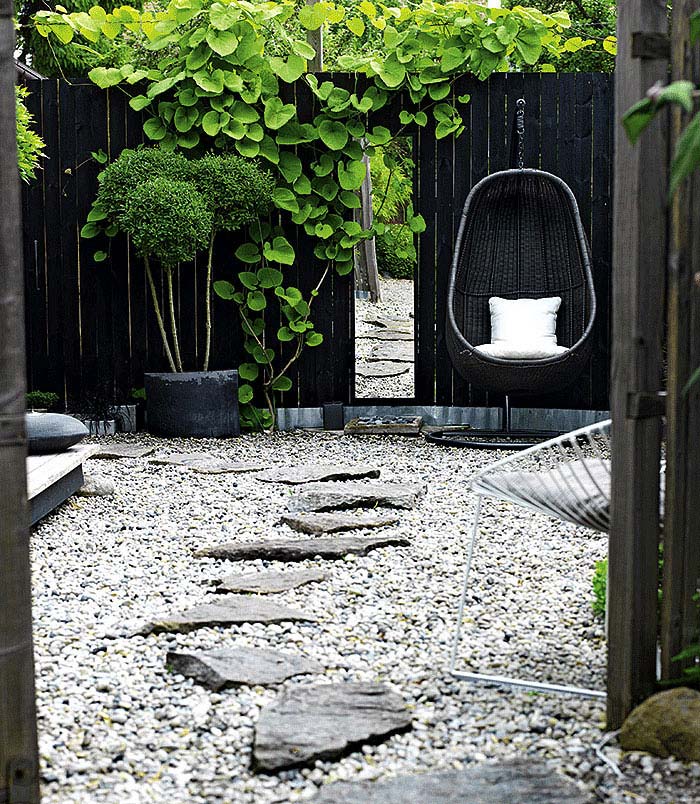
Characteristic for the Asian gardens is the purposely introduced asymmetric. For example – if a path is laid – is never fallowing the straight line of the shortest way – it goes meandering in-between the most visually impressive spots of the garden. The landscape is composed in such a manner that there is never a panoramic view of the entirety of garden – it needs to be explored and enjoyed from the inside to be truly comprehended.
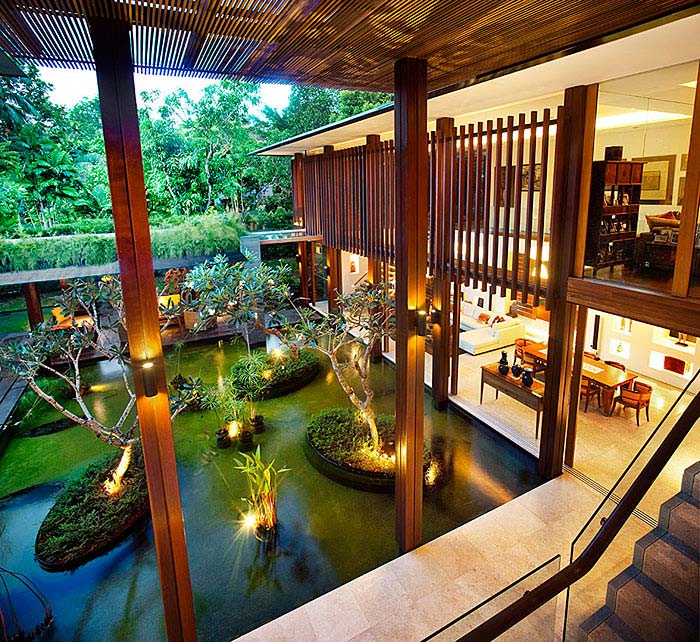
This modern home is located in Singapore, and its fresh lake-garden is laid in the middle of the L-shaped house arrangement. The open premises of the interior allow constant and direct view toward the splendid inside of this unique garden. Compositional approach characteristic for the Asian gardens is applied in this landscape, and it uses visual contradiction between the water and the islands floating on it. Additional exotic emanation comes from the trees and plants that grow on the islands and from the lighting installations arrangement.
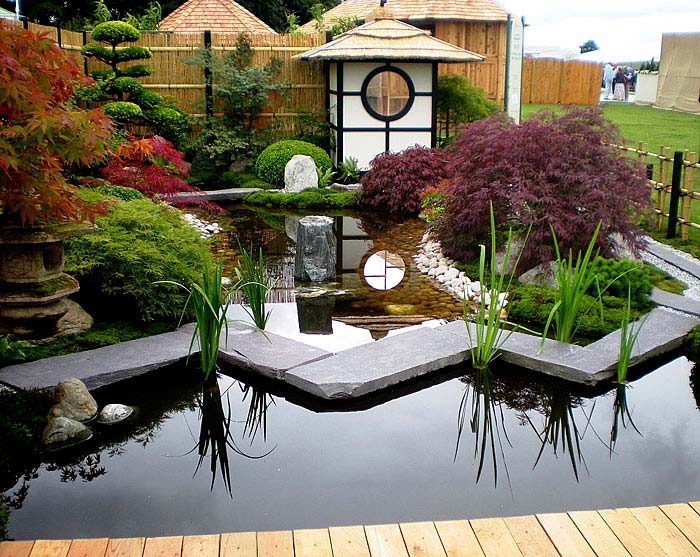
This Contemporary Zen Backyard is again dominated by the water presence and adorned by luscious plant life. Casually spread the red splashes of the Japanese maple trees are contrasting dynamically with the bright greens of the oval – shaped coniferous plants. Granite blocks in zig-shagged arrangement form the walking path that leads you through the water body. The overall Zen sensation of the space is enhanced by the presence of ancient Stone Lantern accent, the bamboo fence and the garden shed designed in Asian style.
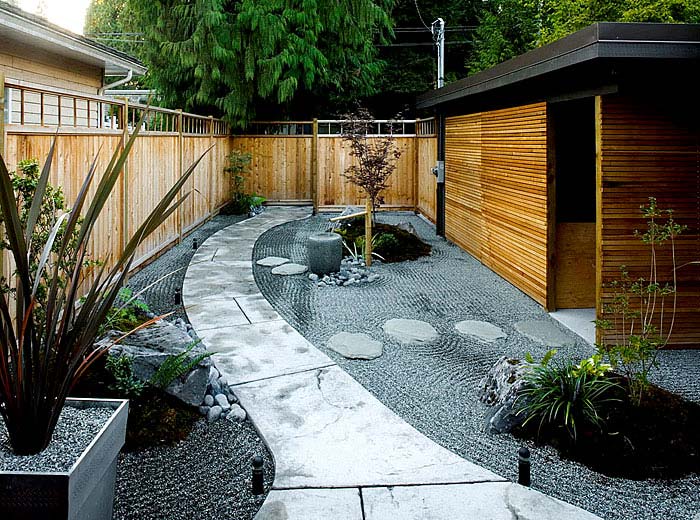
In this example, we observe the traditional for the dry rock gardens gravel base shaped with circles and waves. This solution is not only very visually attractive but is also quite practical because the gravel prevents the growing of unwanted plants. Stepping Stone Pathways, a small rock fountain, and a wooden fence complete the sensation of one contemporary Asian-themed backyard.
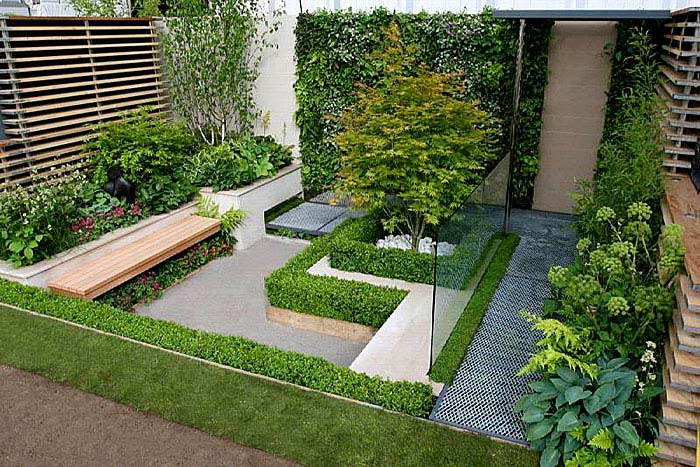
Stylish backyard with urban emanation that uses elements from the Asian Zen gardening in its configuration- Stone statues, river granite for the base of the tree, bench for meditation and walking paths that lead throughout the garden despite its limited size compose this cute little space for relaxation.
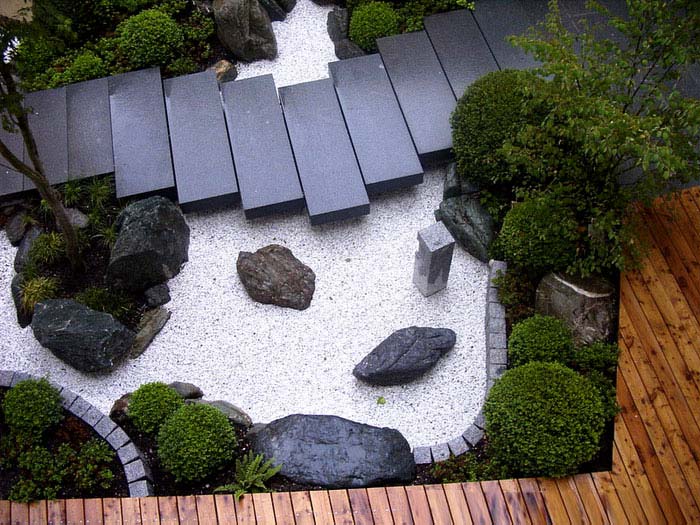
Again here in the foundation of the composition is the walking path – solid rectangle blocks are laid in the center of the composition. White gravel in the lowest part of the arrangement symbolizes the water, and the stone walking path is raised one level above it like a bridge that crosses a river. The straight lines of the wooden platform act as a framing of the composition and are juxtaposed to the organic and oval shapes of the rocks and plants.
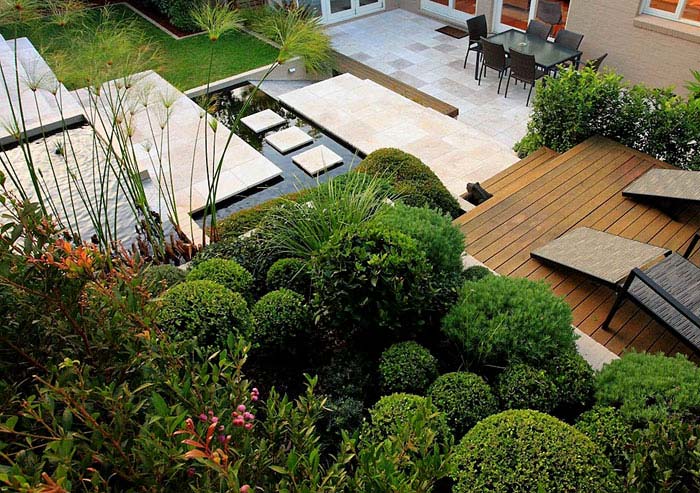
This is one modern interpretation of Zen garden from Australia. Its robust geometrical shapes, a cascade of terraces and plant types are revolving around the contrast of shapes and materials. With two distinctively visible zones – the flat square space covered with water, grass and smooth surfaces and the oval explosion of greenery – the space offers dynamic contradictions and variety.
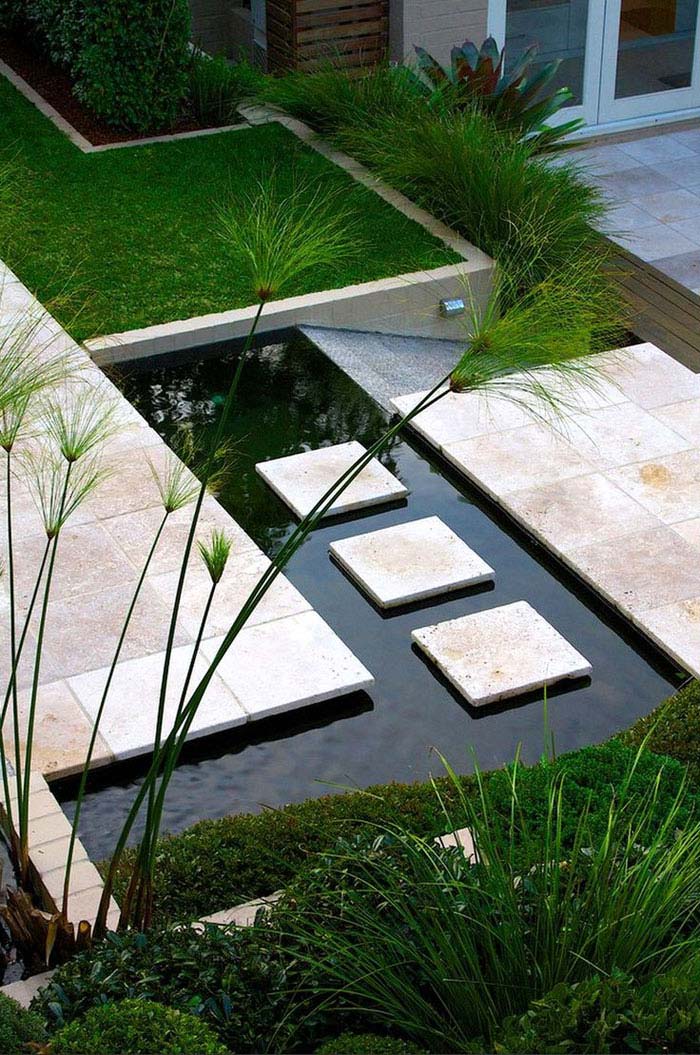
Check out the fallowing gallery of Zen Backyards that shows more elegant combinations between traditional Asian gardens’ elements and modern vision and style.
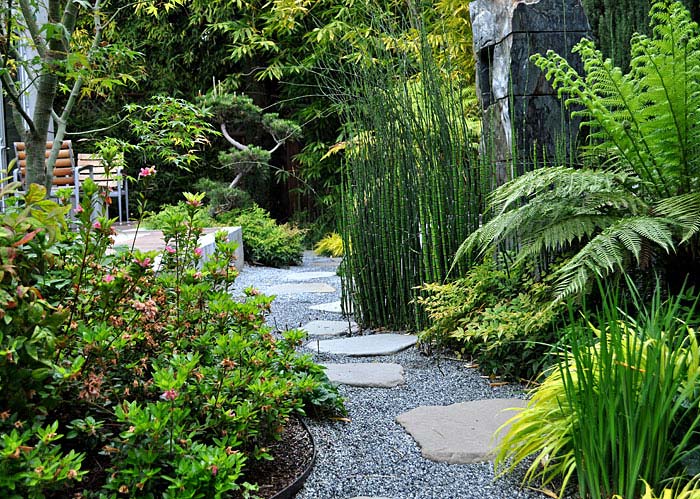
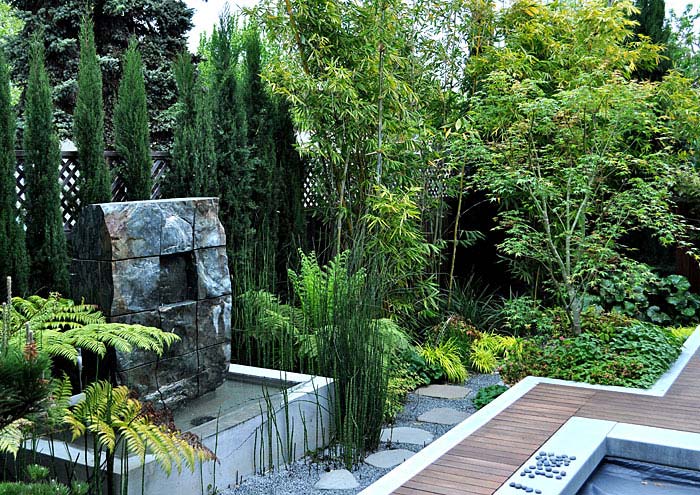
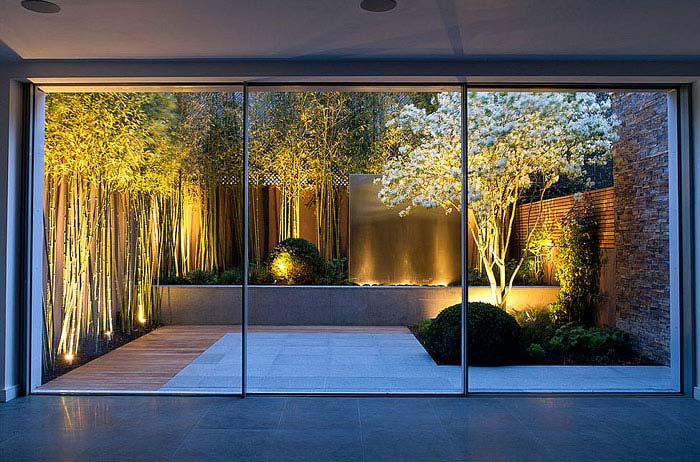
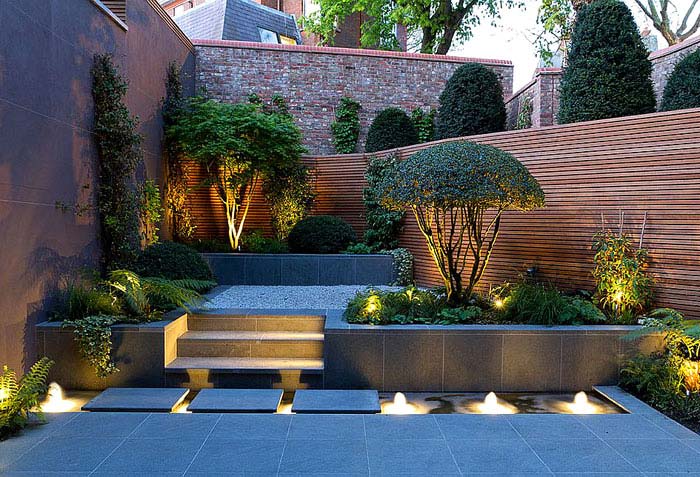
Some charring wood elements can also be a part of a zen garden. Those who crave for a complete Japanese type of home, it is worth considering Shou Sugi Ban siding, also known as Yakisugi. Shou Sugi Ban is a unique, ancient way of preserving wood with fire, giving luxury, aesthetic look and making it both: fire and water resistant.

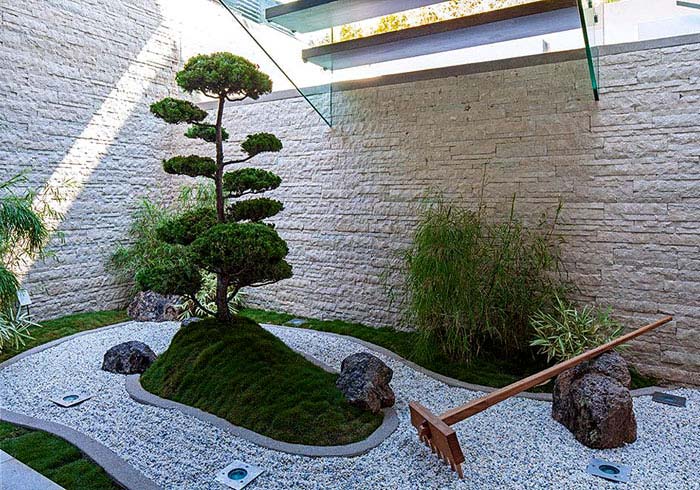
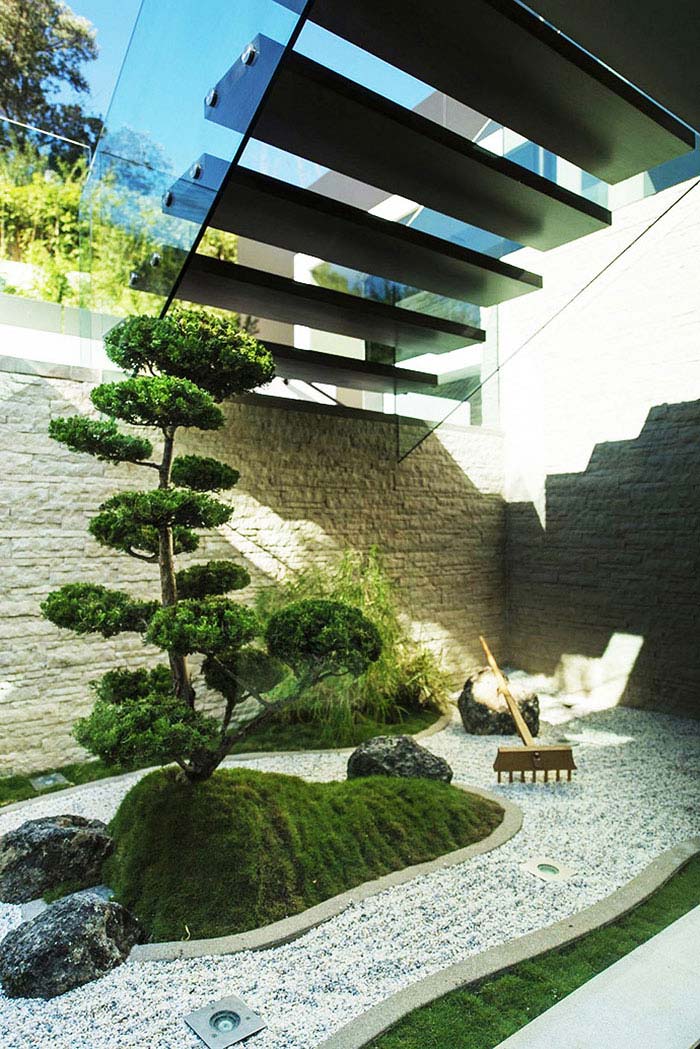
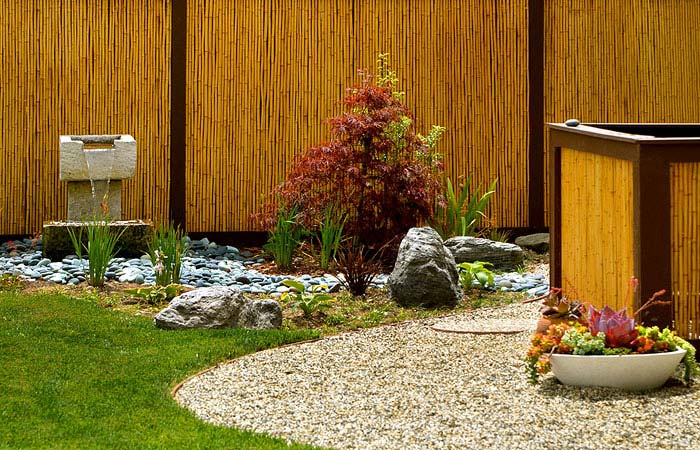
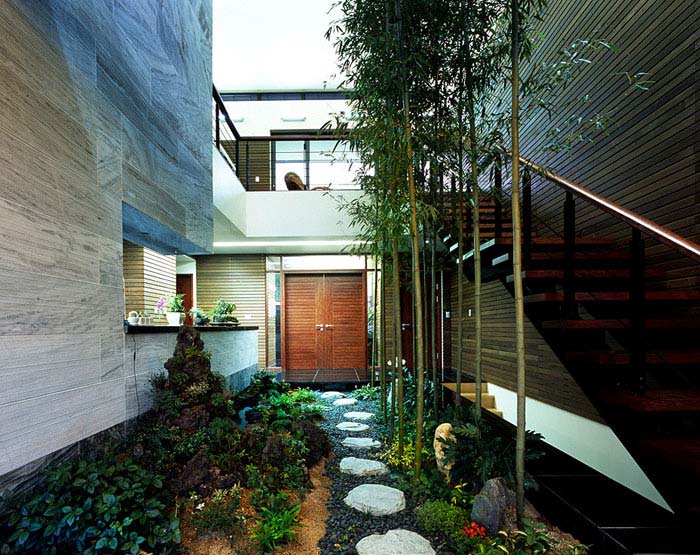
Indoor Zen Garden Ideas
This garden is located at the entrance of a contemporary Korean house. The high bamboo installation visually defines the staircase leading toward the inside of the home. The stone pathway laid in gravel bed brings us towards the other part of the house. A stone cascade decorated with small green plants and moos becomes the focal center of the garden.
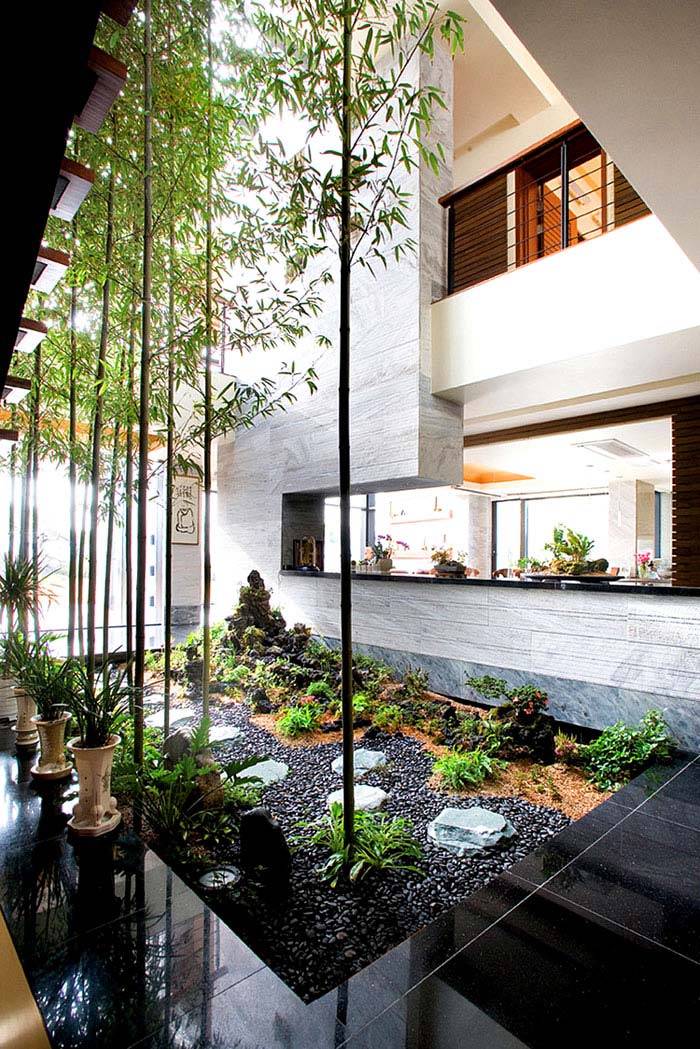

The Zen space can be moved entirely inside the home even like in this case on the second floor of the house. The obstacles in front introducing such a space into the interior composition can be significant but if everything is carefully planned and cleverly executed the outcome is spectacular.
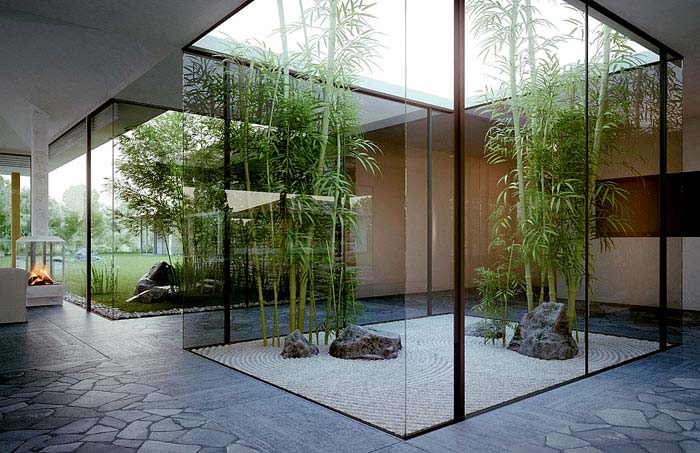
Another unusual solution is found by the architects of this building. The Asian garden is situated in the middle of the house surrounded by glass walls with an opening above and in this way the bamboo is free to grow high and to receive natural sunlight and rain irrigation. Another plus side of this bright house is that the natural sunlight penetrates freely the interior of the home. A harmonic interaction between interior and exterior based on the principal of ying and yang.
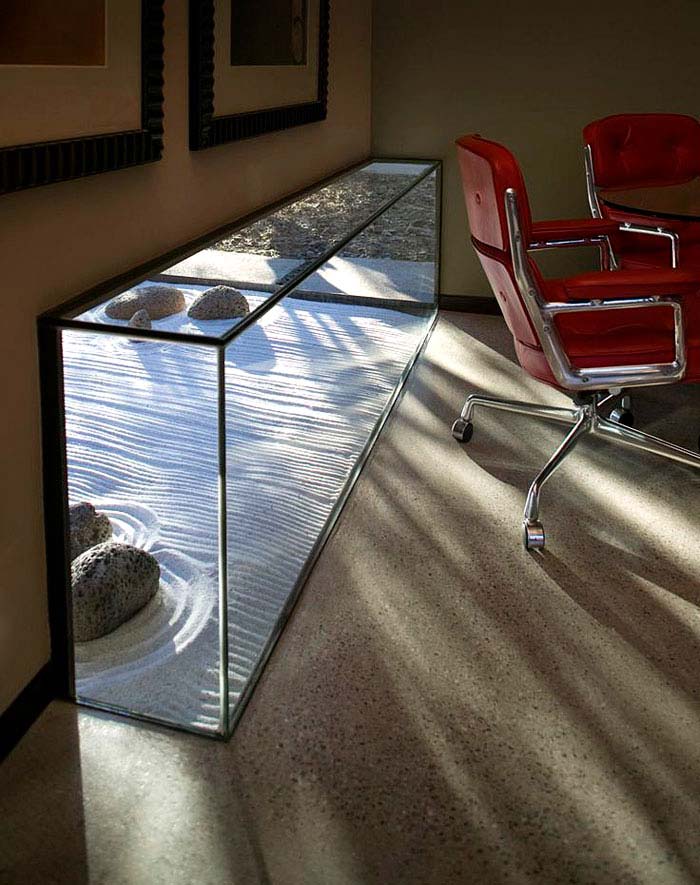
Breaking the borders of ordinary visual perception this Dry Stone garden penetrates the interior in a dynamic and unexpected way with its aquarium-like glass structure. Suitable for its provocative style for office spaces where the out-of-the-box thinking is welcomed.
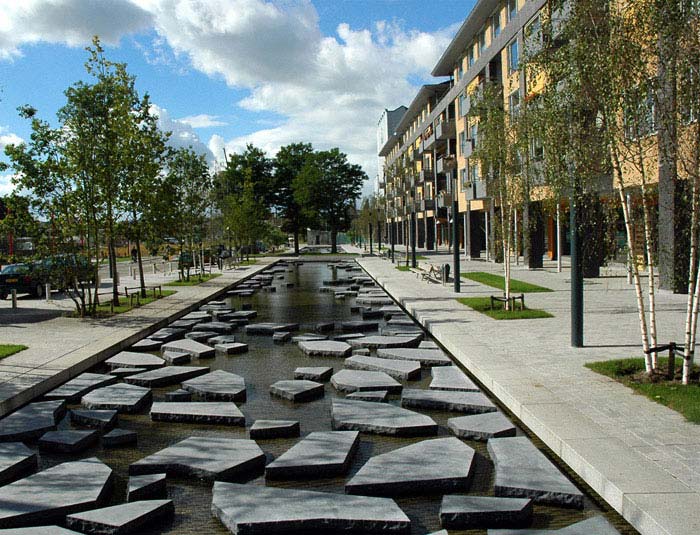
Zen Inspired Public Spaces
Sometimes the forward thinking architects borrow the elegant aesthetics of Zen gardens and giving it a modern read integrate this style into public spaces and city landscapes. Let’s check together some inspirational examples of cleverly arranged relaxing spaces inspired by the East.
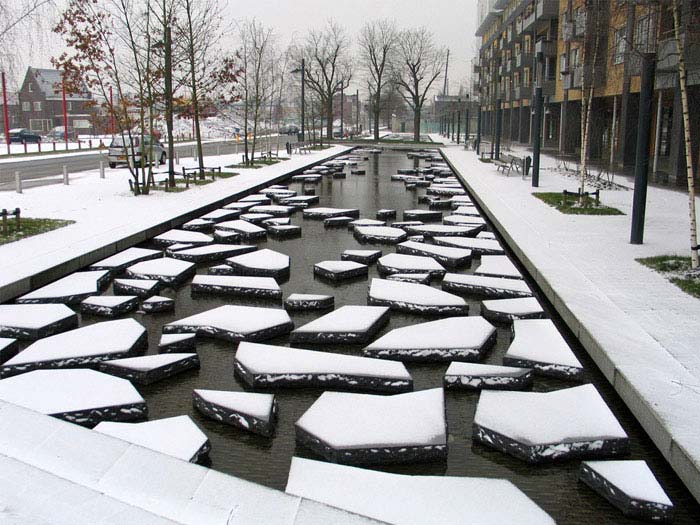
The first project is Roombeek the Brook located in Enschede, Netherlands. An existing water premise is turned into modern Zen garden with irregular patterns of rocks that slow the movement of the water and bring tranquility and charm to its surrounding. The smooth stone blocks laid asymmetrically throughout the water body are inspired by the traditional Stepping Stone Pathways but give that concept a contemporary read.
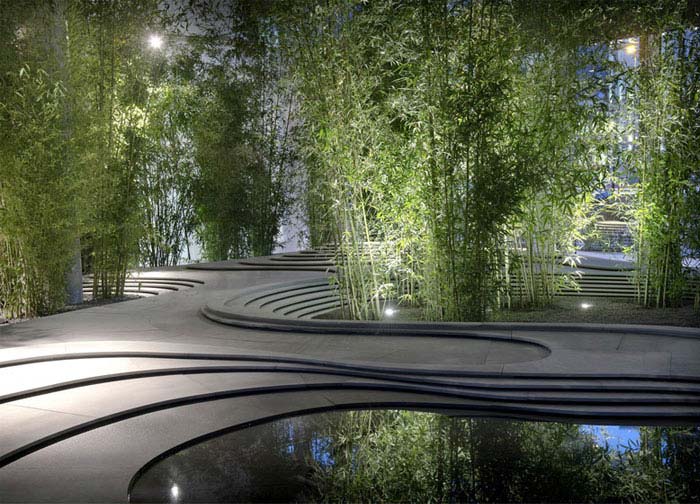
As a part of Urban Stories exhibition – Milan 2013, the installation Naturescape by Kengo Kuma is a modern and provocative interpretation of the traditional Japanese garden. Cascades and layers of smoothly shaped stone waves are combined with water premises at their lower points, and clusters of bamboo planted midst gravel islands.
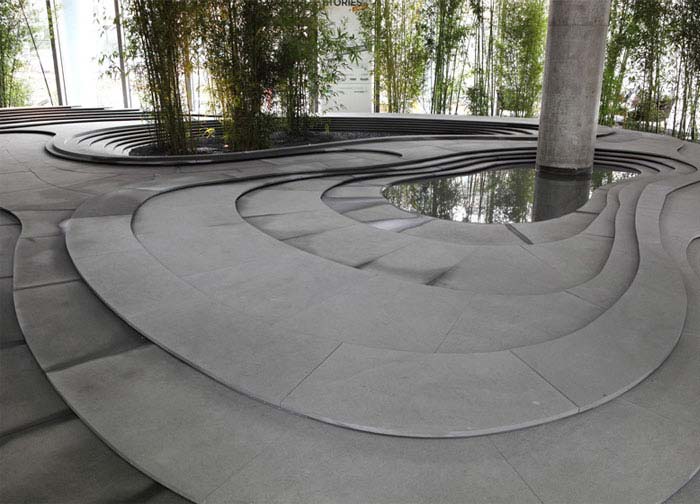

Sunken Garden in Beijing is created by Plasma Studio and presents us with contemporary urban stylistics that is influenced by the Chinese Shouzou gardens. This city park is impressive with its 3G projection, with the multiple hidden pathways and spaces that create a secluded sensation in which one can harmoniously reconnect with nature.
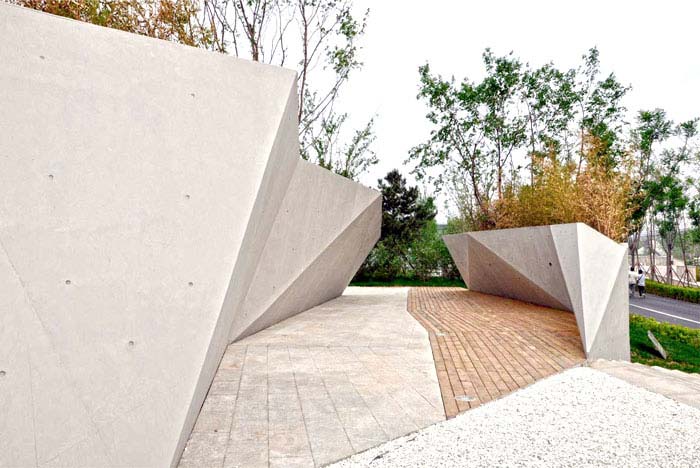
Here are some more spaces for relaxation located in business buildings the architects of which had used elements from the Asian gardens to create a unique atmosphere:
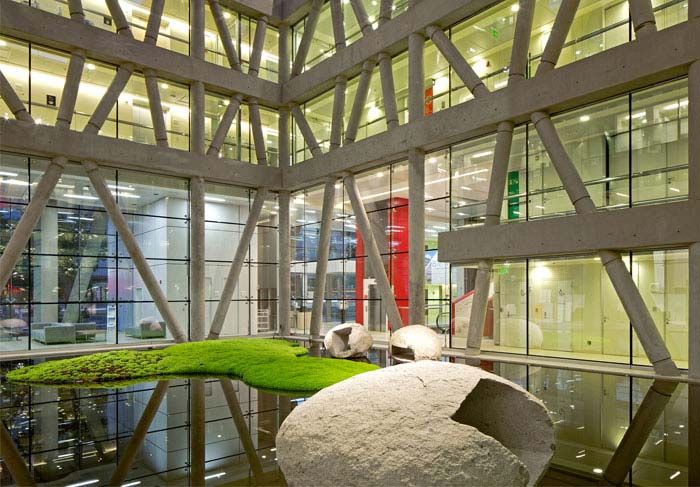
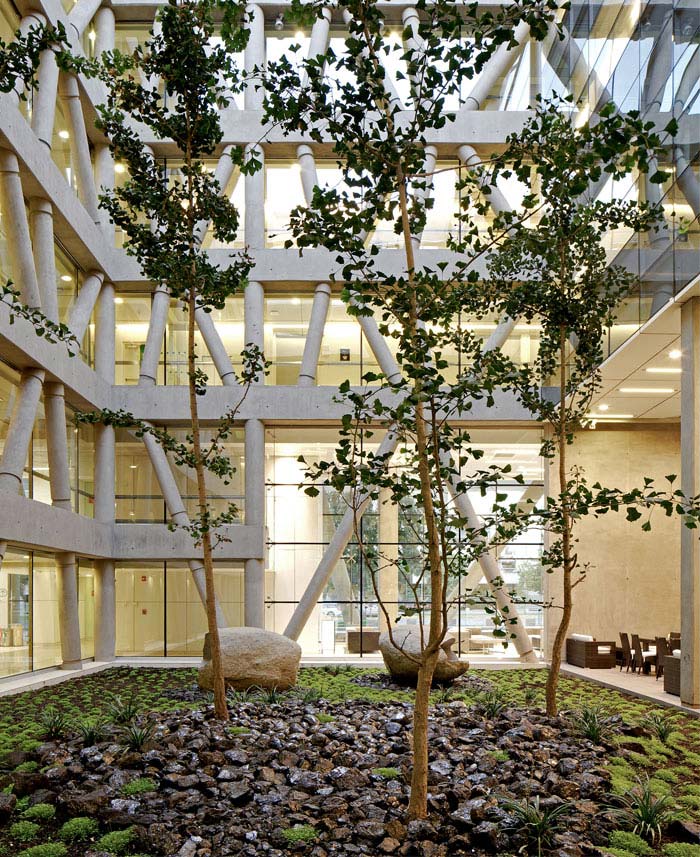
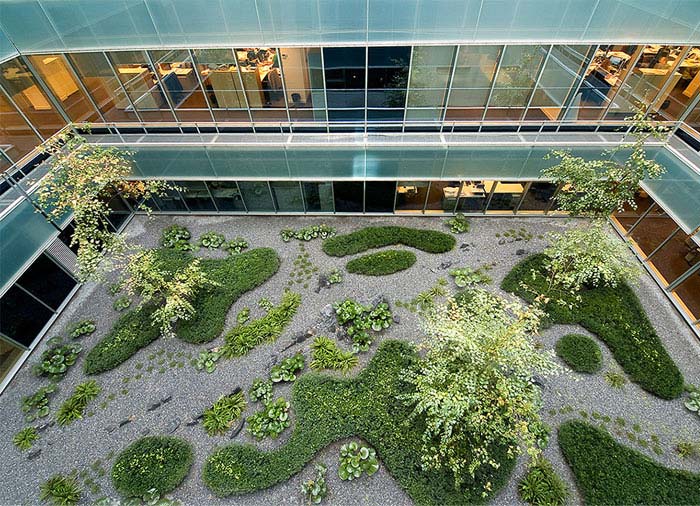
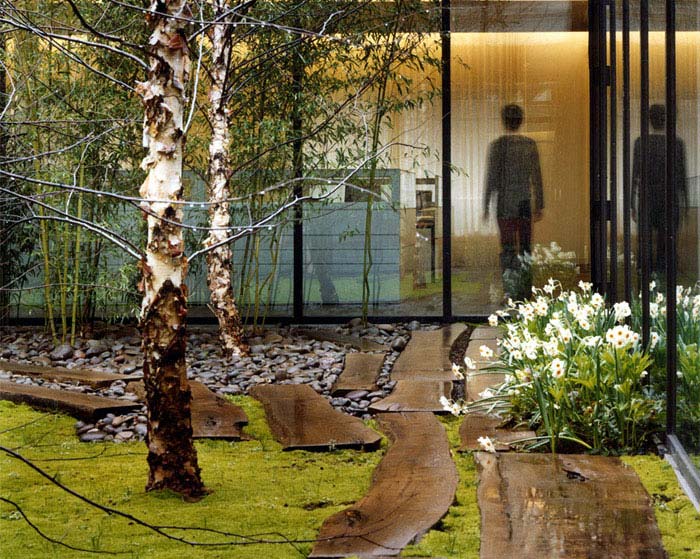
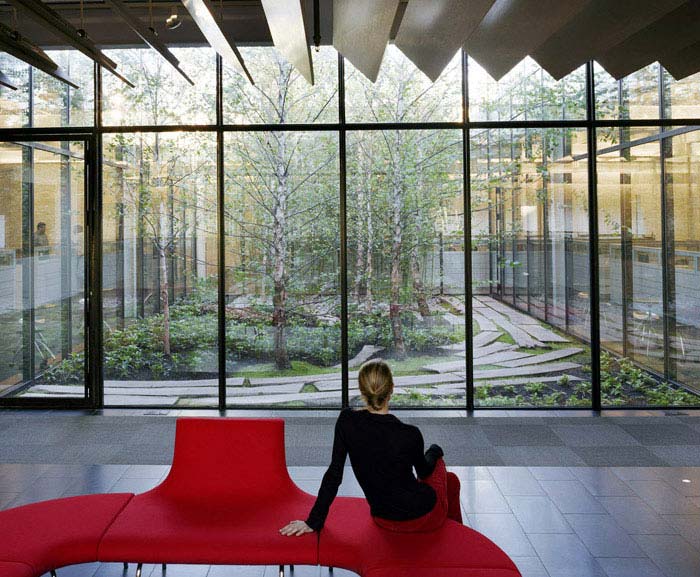

Mini Zen Gardens
If you enjoy the eastern stylistics and the ideas presented to you in this article, but you have no space to create a full-scale Zen Garden in your home – do not disperse – the solution is simple as a miniature zen garden.

Multiple varieties of desktop zen garden can be purchased online and bring the Asian harmony and charm into your home, office or even presented as a gift for a loved one. If you have the patience, ingenuity and steady hands, you can create your dry mini garden by fallowing these simple instructions.
DIY Mini Zen Garden
For the creation of the dry desktop zen garden, you need only a shallow ceramic pot, some sand, and stones. If you prefer a living plants composition –some soil, some unpretentious plans, and moss or even bonsai will do it. Full instructions on how to make a mini zen garden you can find here.
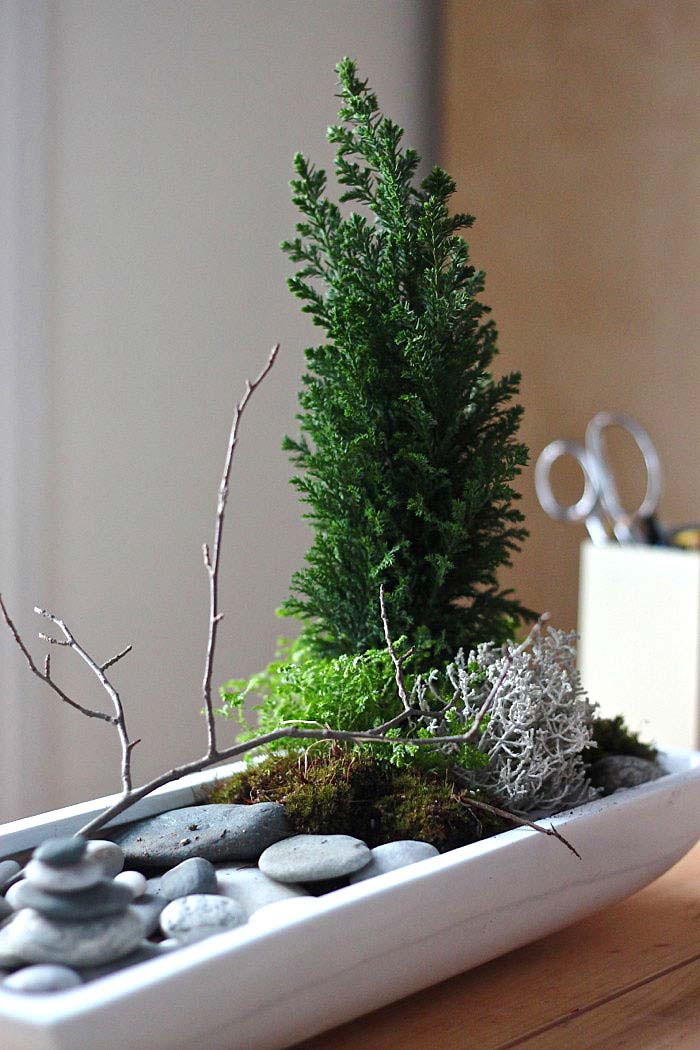
Here is one charming example of how a miniature garden can be placed even in a glass jar. This creates a fairytale-like atmosphere and extravagance but it’s more complicated task to set up and maintain such a garden.

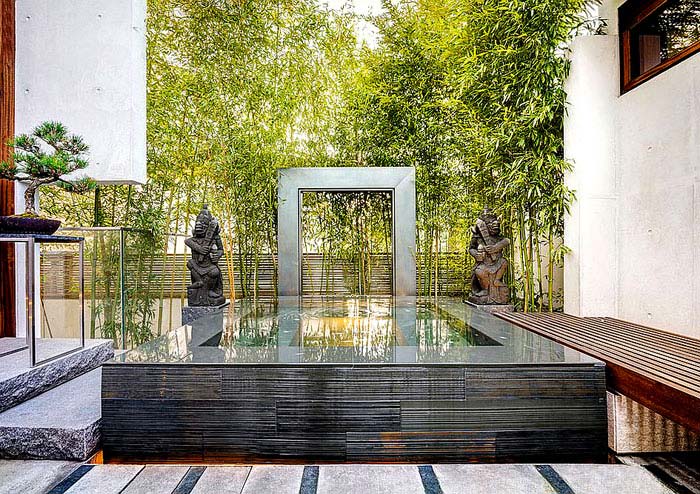
As a conclusion, we advise you to look out for the emerge of the Zen gardens in the creation of homes and spaces in the upcoming interior design season of 2017-2018. Because in the storm of globule events and the stressful and intense everyday life we realize more and more the necessity of some tranquil and harmonic space for meditation, inspiration, and re-charge.
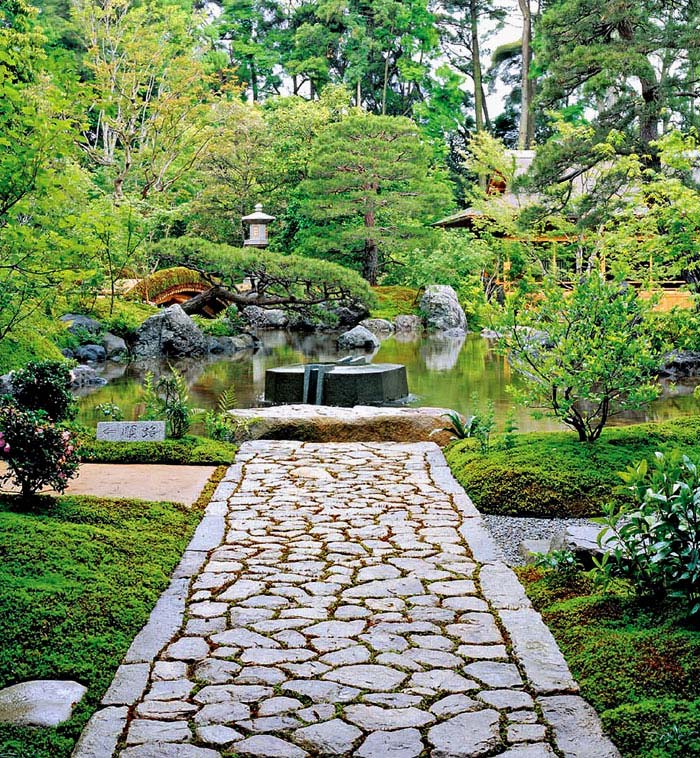
You can check “The Local Tree Experts” to learn more.

